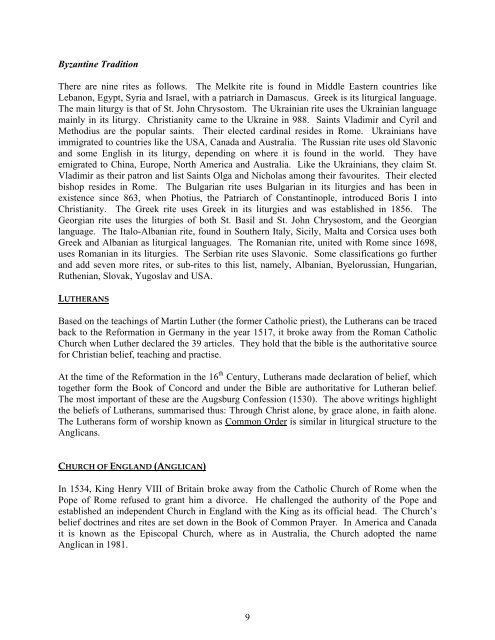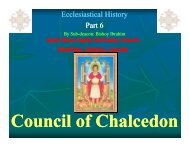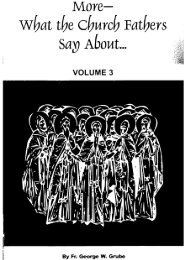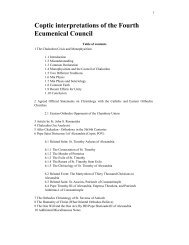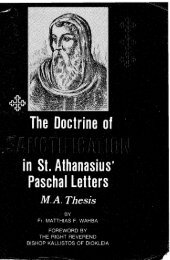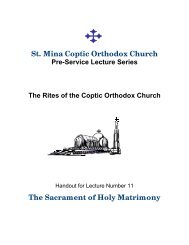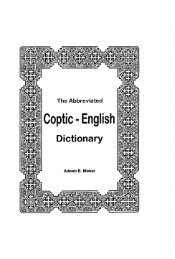Coptic Church & Ecumenical Movement - Saint Mina Coptic ...
Coptic Church & Ecumenical Movement - Saint Mina Coptic ...
Coptic Church & Ecumenical Movement - Saint Mina Coptic ...
Create successful ePaper yourself
Turn your PDF publications into a flip-book with our unique Google optimized e-Paper software.
Byzantine Tradition<br />
There are nine rites as follows. The Melkite rite is found in Middle Eastern countries like<br />
Lebanon, Egypt, Syria and Israel, with a patriarch in Damascus. Greek is its liturgical language.<br />
The main liturgy is that of St. John Chrysostom. The Ukrainian rite uses the Ukrainian language<br />
mainly in its liturgy. Christianity came to the Ukraine in 988. <strong>Saint</strong>s Vladimir and Cyril and<br />
Methodius are the popular saints. Their elected cardinal resides in Rome. Ukrainians have<br />
immigrated to countries like the USA, Canada and Australia. The Russian rite uses old Slavonic<br />
and some English in its liturgy, depending on where it is found in the world. They have<br />
emigrated to China, Europe, North America and Australia. Like the Ukrainians, they claim St.<br />
Vladimir as their patron and list <strong>Saint</strong>s Olga and Nicholas among their favourites. Their elected<br />
bishop resides in Rome. The Bulgarian rite uses Bulgarian in its liturgies and has been in<br />
existence since 863, when Photius, the Patriarch of Constantinople, introduced Boris I into<br />
Christianity. The Greek rite uses Greek in its liturgies and was established in 1856. The<br />
Georgian rite uses the liturgies of both St. Basil and St. John Chrysostom, and the Georgian<br />
language. The Italo-Albanian rite, found in Southern Italy, Sicily, Malta and Corsica uses both<br />
Greek and Albanian as liturgical languages. The Romanian rite, united with Rome since 1698,<br />
uses Romanian in its liturgies. The Serbian rite uses Slavonic. Some classifications go further<br />
and add seven more rites, or sub-rites to this list, namely, Albanian, Byelorussian, Hungarian,<br />
Ruthenian, Slovak, Yugoslav and USA.<br />
LUTHERANS<br />
Based on the teachings of Martin Luther (the former Catholic priest), the Lutherans can be traced<br />
back to the Reformation in Germany in the year 1517, it broke away from the Roman Catholic<br />
<strong>Church</strong> when Luther declared the 39 articles. They hold that the bible is the authoritative source<br />
for Christian belief, teaching and practise.<br />
At the time of the Reformation in the 16 th Century, Lutherans made declaration of belief, which<br />
together form the Book of Concord and under the Bible are authoritative for Lutheran belief.<br />
The most important of these are the Augsburg Confession (1530). The above writings highlight<br />
the beliefs of Lutherans, summarised thus: Through Christ alone, by grace alone, in faith alone.<br />
The Lutherans form of worship known as Common Order is similar in liturgical structure to the<br />
Anglicans.<br />
CHURCH OF ENGLAND (ANGLICAN)<br />
In 1534, King Henry VIII of Britain broke away from the Catholic <strong>Church</strong> of Rome when the<br />
Pope of Rome refused to grant him a divorce. He challenged the authority of the Pope and<br />
established an independent <strong>Church</strong> in England with the King as its official head. The <strong>Church</strong>’s<br />
belief doctrines and rites are set down in the Book of Common Prayer. In America and Canada<br />
it is known as the Episcopal <strong>Church</strong>, where as in Australia, the <strong>Church</strong> adopted the name<br />
Anglican in 1981.<br />
9


